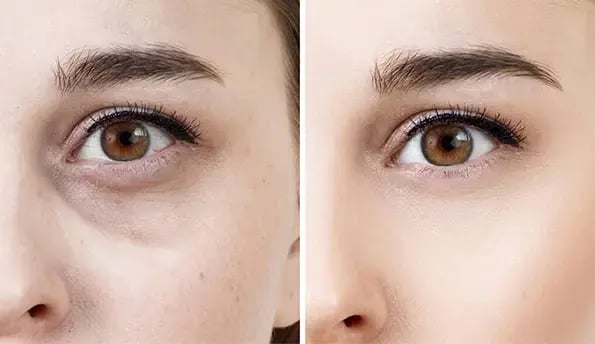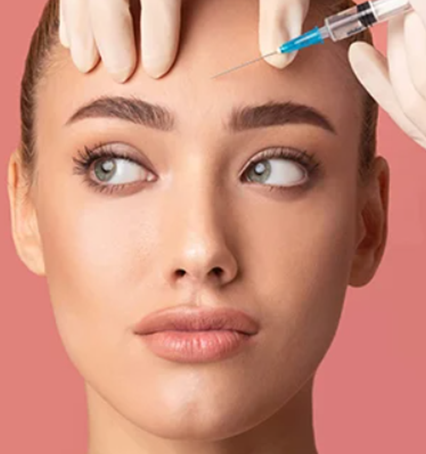What to Know About Under Eye Hollows
Everything You Need to Know About Under Eye Hollows
Under-eye hollows are a common cosmetic concern affecting people of all ages. These hollows appear as sunken or shadowed areas beneath the eyes, often making individuals look tired or older than they are. Understanding what causes under-eye hollows and the available treatments can help you determine the best approach to address this issue.

What Do Under Eye Hollows Look Like?
A sunken appearance beneath the lower eyelids characterizes under-eye hollows. They can create dark shadows or circles under the eyes, contributing to a tired, worn-out look. The hollows may be more noticeable when the face is at rest or in certain lighting, as shadows can accentuate the depth of the area. For some, the hollows can give the impression of a gaunt or unhealthy appearance, even when they are well-rested and healthy.
The extent of under-eye hollows can vary greatly between individuals. In some cases, they may be subtle and only noticeable up close, while in others, they can be more pronounced, affecting the overall balance and symmetry of the face. The skin in this area is delicate and thin, making any changes in volume or pigmentation more noticeable.

Causes of Under Eye Hollows
Several factors can contribute to the development of under-eye hollows, including:
1. Aging: As we age, the skin loses elasticity and fat, which can lead to a sunken appearance under the eyes. The loss of collagen and the weakening of supportive structures in the face contribute to this process.
2. Genetics: Some people are naturally predisposed to developing under-eye hollows due to their facial structure and inherited traits. If family members have under-eye hollows, there’s a higher likelihood that you may experience them as well.
3. Weight Loss: Significant weight loss can lead to a reduction in facial fat, including the area under the eyes, making hollows more prominent.
4. Lack of Sleep: Poor sleep can cause fluid retention and dark circles, which may make under-eye hollows appear more pronounced.
5. Dehydration: When the body is dehydrated, the skin can appear dull and sunken, making under-eye hollows more noticeable.
6. Allergies: Allergic reactions can cause the skin under the eyes to appear swollen and darker, emphasizing the hollows.
7. Sun Exposure: Over time, excessive sun exposure can damage the skin and lead to a loss of elasticity and collagen, contributing to the appearance of hollows.
Our mission is to create a world where every investment in modern beauty is Worth It.
Let's keep in touch
Get updates of the treatments you are interested
Home Remedies for Under Eye Hollows
While home remedies may not eliminate under-eye hollows, they can help reduce their appearance and improve the overall health of the skin:
1. Cold Compress: Applying a cold compress can help reduce swelling and puffiness under the eyes, which may make hollows less noticeable.
2. Hydration: Drinking plenty of water and using a good quality moisturizer can help keep the skin hydrated and plump, reducing the appearance of hollows.
3. Healthy Diet: A diet rich in vitamins and antioxidants, especially vitamin C, can promote skin health and support collagen production, which may improve the appearance of the under-eye area.
4. Adequate Sleep: Ensuring you get enough sleep can reduce the appearance of dark circles and puffiness, which can make hollows less prominent.
5. Sun Protection: Wearing sunscreen and sunglasses can protect the delicate skin under the eyes from sun damage, which can worsen hollows over time.
6. Gentle Massage: Massaging the under-eye area with a light, hydrating eye cream can improve circulation and help reduce puffiness.
Treatments for Under Eye Hollows
For those seeking more effective solutions, several cosmetic treatments can significantly reduce the appearance of under-eye hollows:
1. Dermal Fillers: Injectable fillers, often made from hyaluronic acid, can be used to add volume to the under-eye area. This treatment is quick, minimally invasive, and provides immediate results. Fillers can last anywhere from six months to two years, depending on the product used.
2. Fat Transfer: Fat transfer involves harvesting fat from another part of the body and injecting it into the under-eye area. This treatment offers a more permanent solution compared to fillers, although it requires a more involved procedure.
3. Laser Resurfacing: Laser treatments can improve the texture and tone of the skin under the eyes, reducing the appearance of hollows by stimulating collagen production.
4. Microneedling: This procedure involves tiny needles creating micro-injuries in the skin, promoting collagen production and skin rejuvenation, which can help reduce the appearance of hollows.
5. Chemical Peels: A mild chemical peel can improve the texture and pigmentation of the under-eye area, making hollows less noticeable. This treatment works by exfoliating the skin and encouraging new cell growth.
6. Surgery: In more severe cases, a lower blepharoplasty (eyelid surgery) can be performed to remove excess skin and fat, tightening the area and reducing the appearance of hollows.
Choosing the right treatment for under-eye hollows depends on various factors, including the severity of the hollows, your skin type, and your desired outcome. Consulting with a qualified dermatologist or plastic surgeon can help you determine the best approach for your specific needs.
Under-eye hollows can be a source of concern for many, but there are several options available to help reduce their appearance. From simple home remedies to advanced cosmetic procedures, understanding the causes and treatments for under-eye hollows can help you choose the best solution for achieving a more youthful and refreshed appearance
Our mission is to create a world where every investment in modern beauty is Worth It.
Let's keep in touch
Get updates of the treatments you are interested
Everything You Need to Know About Under Eye Hollows
Under-eye hollows are a common cosmetic concern affecting people of all ages. These hollows appear as sunken or shadowed areas beneath the eyes, often making individuals look tired or older than they are. Understanding what causes under-eye hollows and the available treatments can help you determine the best approach to address this issue.

What Do Under Eye Hollows Look Like?
A sunken appearance beneath the lower eyelids characterizes under-eye hollows. They can create dark shadows or circles under the eyes, contributing to a tired, worn-out look. The hollows may be more noticeable when the face is at rest or in certain lighting, as shadows can accentuate the depth of the area. For some, the hollows can give the impression of a gaunt or unhealthy appearance, even when they are well-rested and healthy.
The extent of under-eye hollows can vary greatly between individuals. In some cases, they may be subtle and only noticeable up close, while in others, they can be more pronounced, affecting the overall balance and symmetry of the face. The skin in this area is delicate and thin, making any changes in volume or pigmentation more noticeable.

Causes of Under Eye Hollows
Several factors can contribute to the development of under-eye hollows, including:
1. Aging: As we age, the skin loses elasticity and fat, which can lead to a sunken appearance under the eyes. The loss of collagen and the weakening of supportive structures in the face contribute to this process.
2. Genetics: Some people are naturally predisposed to developing under-eye hollows due to their facial structure and inherited traits. If family members have under-eye hollows, there’s a higher likelihood that you may experience them as well.
3. Weight Loss: Significant weight loss can lead to a reduction in facial fat, including the area under the eyes, making hollows more prominent.
4. Lack of Sleep: Poor sleep can cause fluid retention and dark circles, which may make under-eye hollows appear more pronounced.
5. Dehydration: When the body is dehydrated, the skin can appear dull and sunken, making under-eye hollows more noticeable.
6. Allergies: Allergic reactions can cause the skin under the eyes to appear swollen and darker, emphasizing the hollows.
7. Sun Exposure: Over time, excessive sun exposure can damage the skin and lead to a loss of elasticity and collagen, contributing to the appearance of hollows.
Our mission is to create a world where every investment in modern beauty is Worth It.
Let's keep in touch
Get updates of the treatments you are interested
Home Remedies for Under Eye Hollows
While home remedies may not eliminate under-eye hollows, they can help reduce their appearance and improve the overall health of the skin:
1. Cold Compress: Applying a cold compress can help reduce swelling and puffiness under the eyes, which may make hollows less noticeable.
2. Hydration: Drinking plenty of water and using a good quality moisturizer can help keep the skin hydrated and plump, reducing the appearance of hollows.
3. Healthy Diet: A diet rich in vitamins and antioxidants, especially vitamin C, can promote skin health and support collagen production, which may improve the appearance of the under-eye area.
4. Adequate Sleep: Ensuring you get enough sleep can reduce the appearance of dark circles and puffiness, which can make hollows less prominent.
5. Sun Protection: Wearing sunscreen and sunglasses can protect the delicate skin under the eyes from sun damage, which can worsen hollows over time.
6. Gentle Massage: Massaging the under-eye area with a light, hydrating eye cream can improve circulation and help reduce puffiness.
Treatments for Under Eye Hollows
For those seeking more effective solutions, several cosmetic treatments can significantly reduce the appearance of under-eye hollows:
1. Dermal Fillers: Injectable fillers, often made from hyaluronic acid, can be used to add volume to the under-eye area. This treatment is quick, minimally invasive, and provides immediate results. Fillers can last anywhere from six months to two years, depending on the product used.
2. Fat Transfer: Fat transfer involves harvesting fat from another part of the body and injecting it into the under-eye area. This treatment offers a more permanent solution compared to fillers, although it requires a more involved procedure.
3. Laser Resurfacing: Laser treatments can improve the texture and tone of the skin under the eyes, reducing the appearance of hollows by stimulating collagen production.
4. Microneedling: This procedure involves tiny needles creating micro-injuries in the skin, promoting collagen production and skin rejuvenation, which can help reduce the appearance of hollows.
5. Chemical Peels: A mild chemical peel can improve the texture and pigmentation of the under-eye area, making hollows less noticeable. This treatment works by exfoliating the skin and encouraging new cell growth.
6. Surgery: In more severe cases, a lower blepharoplasty (eyelid surgery) can be performed to remove excess skin and fat, tightening the area and reducing the appearance of hollows.
Choosing the right treatment for under-eye hollows depends on various factors, including the severity of the hollows, your skin type, and your desired outcome. Consulting with a qualified dermatologist or plastic surgeon can help you determine the best approach for your specific needs.
Under-eye hollows can be a source of concern for many, but there are several options available to help reduce their appearance. From simple home remedies to advanced cosmetic procedures, understanding the causes and treatments for under-eye hollows can help you choose the best solution for achieving a more youthful and refreshed appearance




.webp?width=200&height=200&name=thread-lift%20(1).webp)





